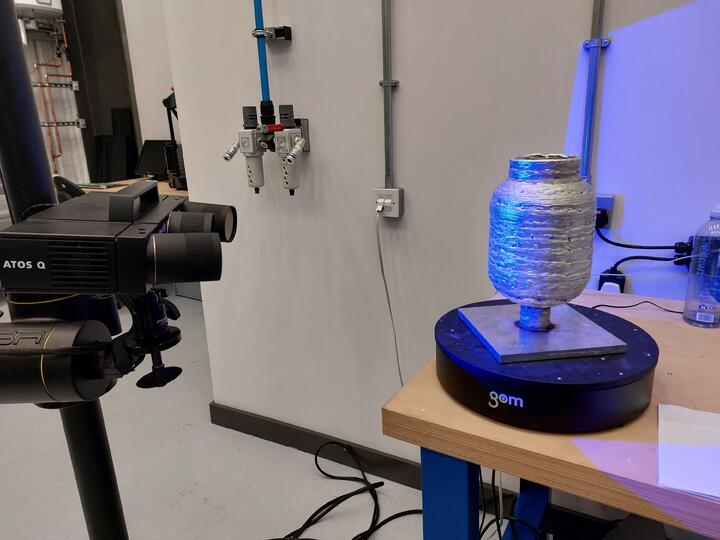Exploring Wire Arc Additive Manufacturing for Aerospace
26 October 2023Additive manufacturing experts from the University of Sheffield AMRC North West are exploring an innovative technique to produce hydrogen storage tanks for aerospace applications.
Article featured in the latest issue of the AMRC Journal.
Dr Evren Yasa, head of additive manufacturing (AM) for the AMRC, led a team of researchers on a project using Wire Arc Additive Manufacturing (WAAM) – a production process used to 3D-print metal parts that uses an electric arc to melt a metal wire, depositing layers of melted metal on top of each other, until a desired 3D shape is created.
WAAM is used in many industrial sectors, including energy, defence, automotive, construction and aerospace, to produce large and complex structural components - reducing the need for assembly and joining technologies, as well as waste material. Moreover, WAAM has been deployed for repair and remanufacturing purposes in aerospace, saving time and costs. In addition, it has the advantage of greater supply chain flexibility, enabling on-demand production in small quantities.
Dr Yasa said: “This project was initiated to utilise our in-house WAAM capability to construct a demonstrator storage tank for liquid hydrogen using an aluminium alloy for use in the aerospace sector – and showcase the complete value chain for producing finished AM parts.”
Hydrogen is a highly sustainable energy carrier and is considered as a key to achieving climate neutrality in the EU by 2050. However, challenges around how to store hydrogen limit its full potential, says Dr Yasa.
“The main challenges of storing hydrogen for use as a fuel source in aerospace, are the additional storage requirements, along with the complicated geometry needed for integral tanks as well as operation at cryogenic temperatures when it is stored in liquid form,” she said.
“These challenges make AM technologies one of the promising manufacturing routes for hydrogen storage tank demands, which is also supported by the Cryogenic Hydrogen Fuel System and Storage Roadmap Report published by the UK’s Aerospace Technology Institute in 2022.”
Currently, sheet metal forming, machining and welding are used for metallic tank production. However, these conventional techniques do not offer the design freedom to make novel shapes. WAAM provides design freedom, which resulted in the AMRC team being able to make an array of more complex shapes, compared with the standard cylindrical/spherical shape – opening up the opportunity, particularly in aerospace, to have the potential to store hydrogen in more compact areas.
Dr Yasa’s team wanted to explore the feasibility of using WAAM for metallic storage tanks by identifying the process parameters, as well as the deposition strategies, for good mechanical properties. Furthermore, the aim was to investigate and counteract the residual stresses occurring due to the high heat input generated during the WAAM process.
Dr Muhammad Shamir, technical lead within the AM team at AMRC North West, explained how different types of heat sources can be employed in WAAM, for example, an electric arc or a plasma arc to melt the wire feedstock material, adding: “For our research, we focused on an electric arc process using a special technique to minimise heat input.”
The project took the team on a steep learning curve, as the equipment used was new to them, said Dr Yasa, adding: “The material was also difficult to work with as aluminium alloys are susceptible to oxygen and hydrogen pick-up. If the material is left in ambient air for too long, it begins to pick up moisture, leading to excessive porosity during processing – deteriorating the mechanical properties.”
Other challenges surfaced during the project included the narrow process window giving a limited range of suitable process parameters, and five-axis programming for complex geometries. However, overall, Dr Yasa said the research work was beneficial as it enabled the team to explore these challenges of WAAM processing aluminium alloys.
The seven-month project was funded through the High Value Manufacturing (HVM) Catapult, of which the AMRC is a member alongside six other national research centres. Dr Yasa and her team now want to push the research to a second phase and are awaiting the result of a further funding bid to explore the effect of AM on the cryogenic mechanical properties, as well as hydrogen permeability to ensure that it is a feasible route for liquid hydrogen applications.
“We have applied for funding to carry out more work on the process optimisation, as well as having the opportunity to test WAAM materials at cryogenic temperatures in a collaboration with the University of Southampton,” Dr Yasa said.
“Moreover, AM for hydrogen storage tanks in aerospace presents challenges, including regulatory approval, standardisation, cost, and industry acceptance.
“Our future projects will focus on overcoming these challenges by collaborating with industry stakeholders, ensuring compliance with standards and regulations, establishing additive manufacturing guidelines, conducting cost-benefit analyses, and fostering acceptance through engagement and knowledge-sharing with the aerospace industry.
“The goal is to showcase the economic viability and competitiveness of this solution.”


